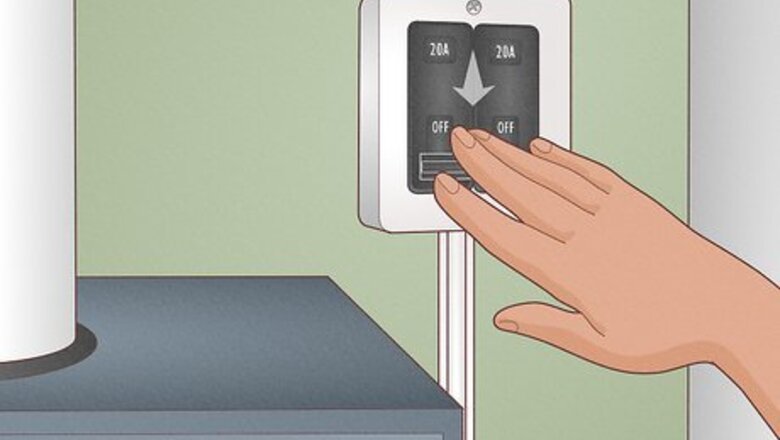
views
- Clean a reusable home HVAC air filter by vacuuming it and then rinsing it under running water. Remove heavy grime with soapy water or a mix of white vinegar and water.
- Clean a dry car air filter by vacuuming and washing it with soapy water, or an oiled air filter by applying a filter cleaning solution then re-oiling it once it's dry.
- Clean an air purifier filter by vacuuming it or wiping it with a clean, dry cloth.
Cleaning a Home HVAC Air Filter
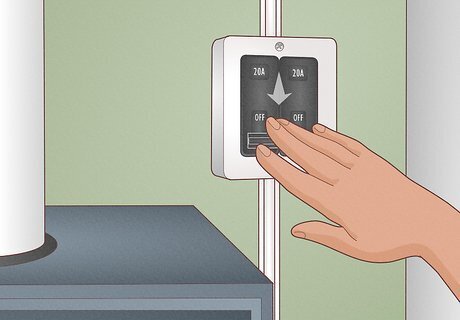
Turn the system off before touching the filter. Clean the area around the vent with a broom or vacuum before opening the vent. Open the screw(s) or latch and swing open the vent. Vacuum the encasement area, then take out the air filter. If the system isn’t turned off first, it will suck in debris during the cleaning process. Use a step ladder if the vent is up on the ceiling or a high wall. If you’re cleaning a portable air conditioning unit, be sure to unplug it. While the following steps are the general instructions for cleaning a home HVAC air filter, always check the instructions for your specific air filter model to ensure you clean it correctly. Make sure that your filter is reusable and washable.
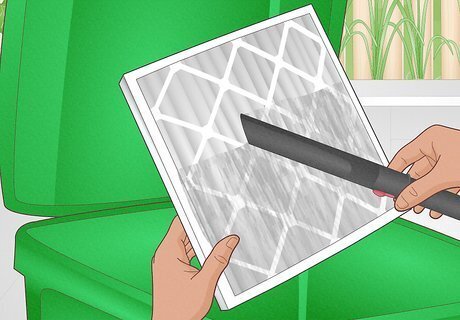
Brush off the excess dirt, then vacuum the filter. Brush dirt off the filter into a trash container outside. Connect a hose attachment to your vacuum cleaner. Vacuum dust and debris from the filter with an upholstery attachment on the filter’s front, back, and sides. Vacuum the filter outside, if possible, to avoid stirring up dust in the home.
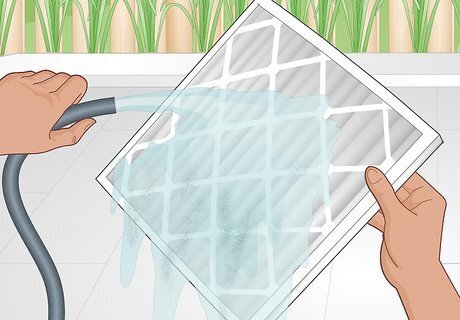
Rinse a reusable filter under running water. Attach a hose to your water tap, and hold the filter so that the water flows the opposite way from the airflow. Spray the filter completely to wash off dust and dirt. Use a gentle spray, not the full force of your hose, to avoid damaging the filter.
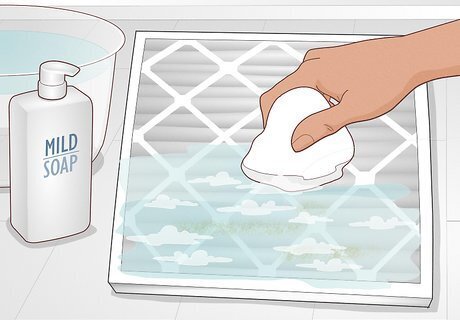
Wash off heavy grime with a soap solution, if needed. If a simple rinse doesn’t do the job, soak your filter in a soap solution. Add some mild liquid detergent to 2 cups (470 mL) of warm water in a bowl. Stir the solution. Wet a cloth in the solution and wash both sides of your filter. Rinse the filter with water, and let it dry completely. After the final rinse, shake off any excess water before setting the filter out to dry. Wash your filter with a soap solution if it’s been exposed to grease, smoke, or pet hair. If you’re cleaning an HVAC filter, you can use try white vinegar and water. Fill a bucket with equal parts hot water and white vinegar and allow your filter to soak for an hour. Then, rinse it with clean water.
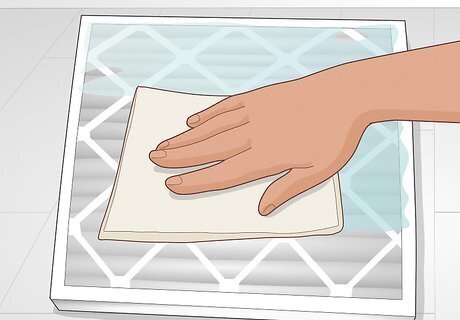
Dry the filter thoroughly. Pat the filter dry with paper towels. Leave the filter outside so it can air-dry. Make sure that the filter is completely dry before re-installing it. Neglecting to let the filter dry completely can cause mold growth, which can spread spores throughout your home through the HVAC. Generally, clean filters take about 10 hours to dry, though this varies depending on the model and where it’s drying.

Reinstall the filter. Place the filter back in its housing and ensure that the airflow is facing in the proper direction. Close the vent, and secure any screws or latches. The filter should sit snugly, without appearing too small or warped. Make sure there are no gaps.
Cleaning a Car Air Filter
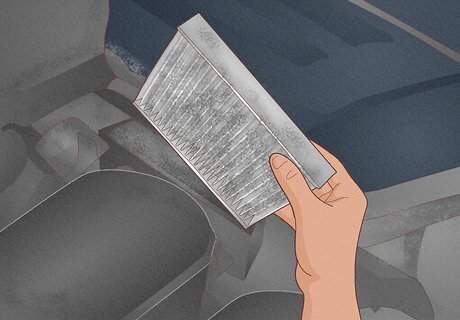
Remove the filter from the inside of your car. The air filter’s housing should be on top of the engine, in a round or rectangular box. If you can’t locate the filter, check the physical or online vehicle manual. Alternatively, ask a mechanic the next time your vehicle is serviced. Open the canister (usually secured with wing nuts or clamps), and pull the filter out.
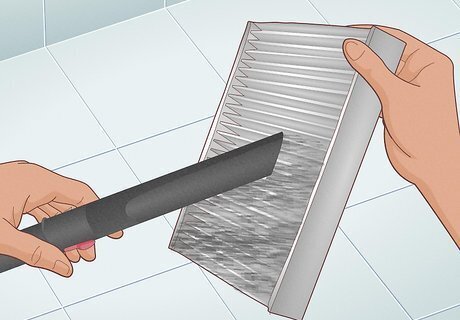
Vacuum and wash a dry filter. Connect a hose attachment to your vacuum cleaner. Vacuum the filter for about a minute on each side. Look at the filter under a bright light, and vacuum any spots you may have missed. If your filter is very dirty, fill a bucket with water and a small amount of laundry detergent. Place the filter in the bucket and swirl it around. Take the filter back out and shake off excess liquid, then rinse the filter gently under running water. Put it on a towel and allow it to dry completely. Don’t put the filter back when it’s still wet! This can damage the vehicle’s engine. Washing is riskier than vacuuming alone because of the serious damage it can cause. Drying time can take up to 24 hours, so make sure you give it enough time to dry completely before you need to use your car again.
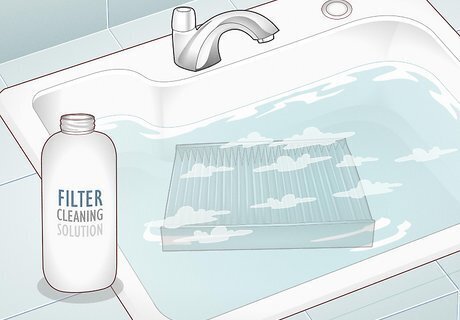
Wash an oiled filter with a cleaning solution, then re-oil it. Tap the filter to shake off dust and dirt. Apply a cleaning solution (specifically for oiled filters) liberally to the outside, then inside of the filter. Make sure the filter is completely saturated, then leave it in a sink or basin for ten minutes. Rinse it with cool water at a low pressure. Shake it off and allow the filter to completely dry. Don’t allow the cleanser to dry on the filter; let it sit for only 10 minutes. Rinse the filter by moving it up and down under the stream of water. After the rinse, the filter should dry in about 15 minutes, but allow it to sit longer if it isn’t thoroughly dry. Coat the filter thoroughly with a thin layer of air filter oil. Wipe off any excess oil from the cap and bottom lip of the filter. Allow the filter to sit for 20 minutes to absorb the oil.
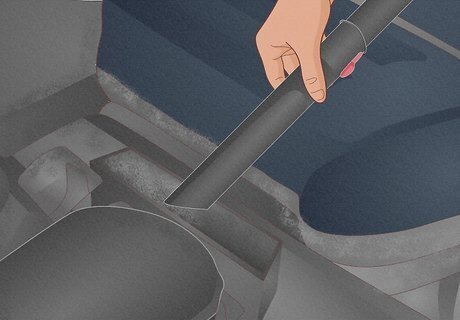
Clean out the canister with a vacuum. Vacuum dust and dirt from the filter housing using a hose attachment. Alternatively, use a soft cloth or paper towel. Just make sure the canister is completely dry and free of debris before replacing the filter. Moisture and debris can cause damage to the engine.

Reinstall the filter. Return the filter to its housing and secure any locks or clamps that hold it in place. These will be the same ones you undid when you removed the filter.
Cleaning an Air Purifier Filter
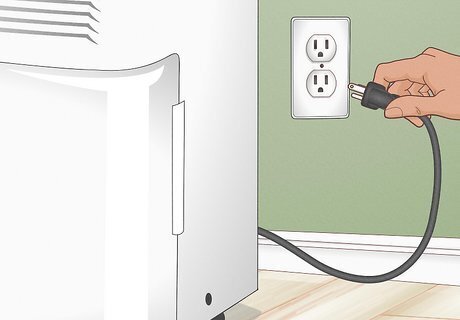
Turn off and unplug the air purifier. Before cleaning the filter, put on a face mask and gloves to protect yourself from any strong pollutants the air purifier captures. Make sure anyone with strong allergies leaves the room, as debris might be released during the cleaning process. The exact cleaning process depends on the type of air purifier you have, so always check your user’s manual before attempting to clean it.

Wipe and vacuum the exterior of the air purifier. Use a clean, damp cloth to wipe down the exterior, then use a vacuum attachment on a low setting to remove dirt and dust from the air intake grill.
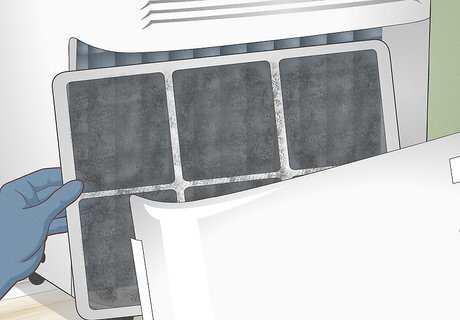
Remove the interior parts and the filter. Following your user’s manual, disassemble the air purifier and remove its internal components. There may be release buttons to push on the exterior or screws you need to remove depending on the manufacturer.
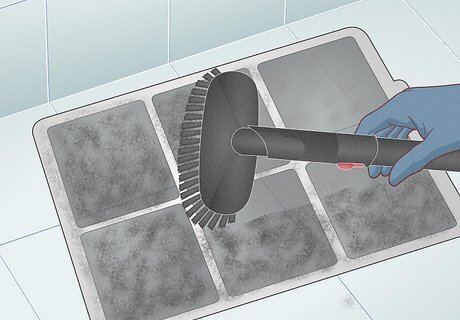
Wipe and vacuum the filter and internal components. Use a soft brush attachment on your vacuum to gently remove dust and debris. If your model allows it, vacuum or wipe the inside of the air purifier with a clean, dry cloth. A lot of air purifier filters cannot get wet, but there are a few that can be washed with warm water. Only use water if your model specifically states it can get wet, and let it dry completely before reinstalling. Wet filters can cause mold. Use a compressed air duster for both washable and nonwashable filters for a light cleaning session.
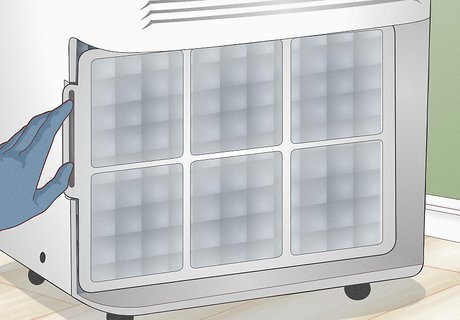
Replace the filter and reassemble the air purifier. Put all the internal components back into place and put the unit back together. Then, plug it back in and turn it on.
When to Clean or Replace Air Filters

Replace disposable air filters. A cleanable air filter is advertised as “washable,” “permanent,” and/or “reusable.” Don’t wash paper or otherwise disposable air filters. Avoid vacuuming them as well. Washing disposable air filters can actually clog them, as well as cause mold. Disposable filters can tear under the pressure of vacuuming or compressed air. At a low pressure, this may work temporarily, but it’s not a long-term solution.
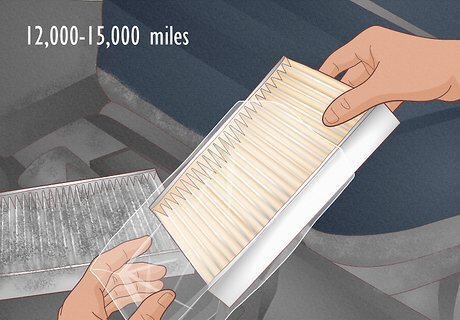
Clean or replace your car air filter every 12,000 to 15,000 miles. You may need to do it more often if you travel on dusty roads or in polluted areas. Examine your air filter under a bright light. Clean or change the filter if it’s darkened or clogged with debris. Disposable filters should be replaced, whereas permanent filters can be vacuumed or washed. If you don’t change your air filter as needed, you may notice a decrease in your gas mileage, ignition problems, or fouled spark plugs.
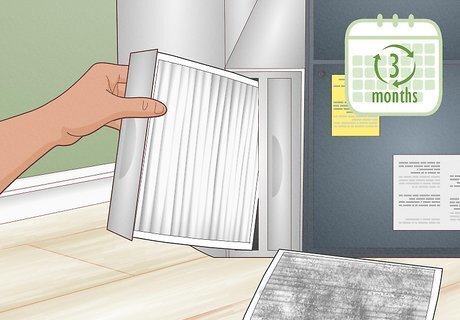
Clean or replace your home air filter every 3 months. Clean or change the furnace filter monthly during the heating season. Clean or replace your central air filter every month or two in the cooling season. If your filter is disposable, replace it. If it’s reusable, vacuum or wash it. If your filter is exposed to a lot of dust or pet hair, you’ll need to change it more frequently. Failing to clean your air filters in the home can cause HVAC failure or even fire.
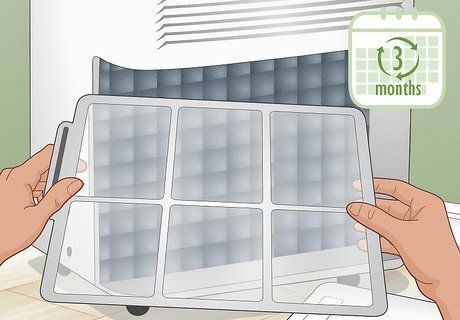
Clean permanent air purifier filters every 3 months. Replace them when they appear worn and damaged. Replace unwashable carbon and HEPA filters about every 12 months.










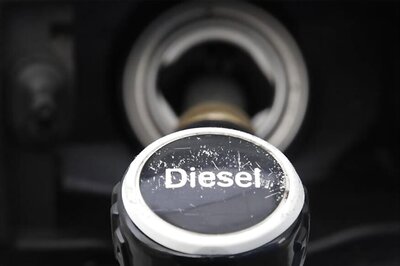






Comments
0 comment